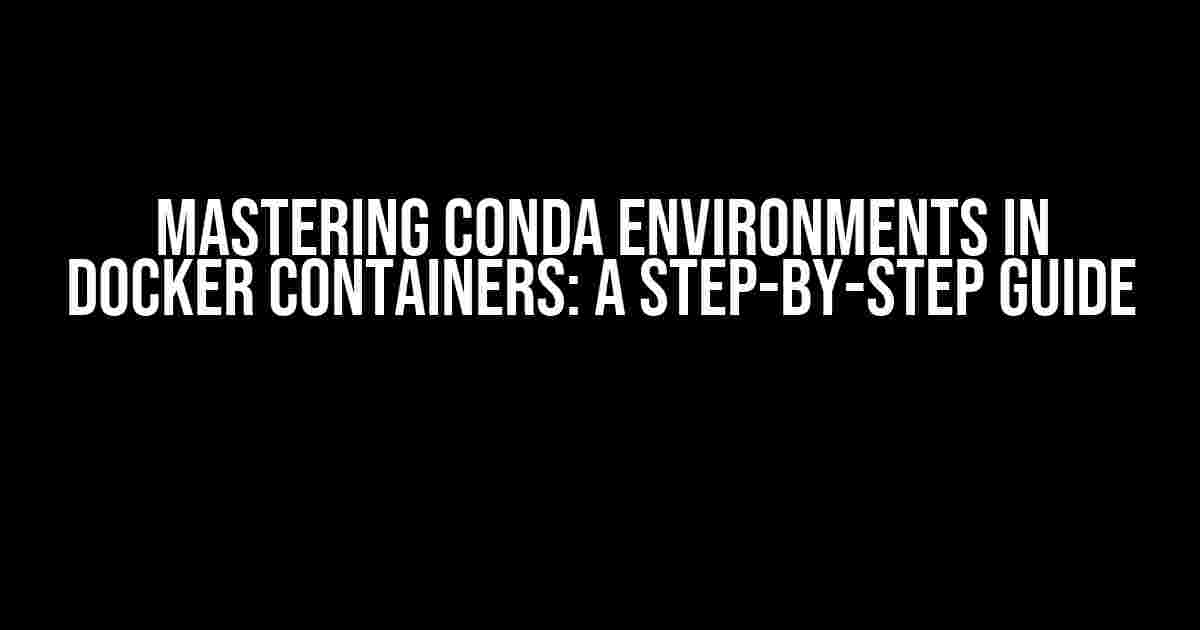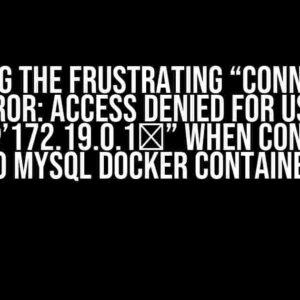Are you tired of juggling dependencies and package versions in your data science projects? Look no further! In this article, we’ll dive into the world of Conda environments and Docker containers, and provide a comprehensive guide on how to create and activate a Conda environment in a Docker container. By the end of this tutorial, you’ll be equipped with the knowledge to streamline your workflow and take your projects to the next level.
- What is a Conda Environment?
- Step 1: Install Docker
- Step 2: Pull a Docker Image
- Step 3: Create a Docker Container
- Step 4: Activate Conda in the Container
- Step 5: Create a New Conda Environment
- Step 6: Activate the New Conda Environment
- Step 7: Install Dependencies and Libraries
- Step 8: Verify the Conda Environment
- Step 9: Deactivate and Exit the Container
- Step 10: Save and Share Your Conda Environment
- Conclusion
What is a Conda Environment?
A Conda environment is a self-contained space that allows you to manage dependencies and package versions for your projects. It’s like a virtual playground where you can experiment with different libraries and tools without cluttering your system. Conda environments are created using the Conda package manager, which is part of the Anaconda distribution.
Why Use Conda Environments in Docker Containers?
Docker containers provide a lightweight and portable way to deploy applications. By combining Conda environments with Docker containers, you can create a reproducible and isolated environment for your projects. This approach ensures that your project dependencies are consistent across different machines and environments, making it easier to collaborate and deploy.
Step 1: Install Docker
Before we dive into creating a Conda environment, you’ll need to have Docker installed on your system. If you haven’t already, follow these steps:
-
Head over to the Docker website and download the suitable installation package for your operating system (Windows, macOS, or Linux).
-
Follow the installation instructions to set up Docker on your system.
-
Verify that Docker is installed correctly by running the command
docker --versionin your terminal.
Step 2: Pull a Docker Image
Next, we’ll need to pull a Docker image that contains the Conda package manager. We’ll use the official Anaconda image as a base:
docker pull continuumio/anaconda3This command pulls the latest Anaconda 3 image from the Docker Hub repository.
Step 3: Create a Docker Container
Now, let’s create a new Docker container based on the pulled image:
docker run -it --name my_conda_container continuumio/anaconda3This command creates a new container named my_conda_container from the Anaconda 3 image. The -it flag allows us to interact with the container and view its output.
Step 4: Activate Conda in the Container
Once you’re inside the container, activate the Conda environment:
conda activateThis command activates the default Conda environment, which is usually named base.
Step 5: Create a New Conda Environment
Let’s create a new Conda environment for our project:
conda create --name my_project-env python=3.8This command creates a new environment named my_project-env with Python 3.8 as the interpreter. You can customize the environment name and Python version to suit your needs.
Step 6: Activate the New Conda Environment
Activate the new Conda environment:
conda activate my_project-envThis command switches us to the new environment, where we can install project-specific dependencies and libraries.
Step 7: Install Dependencies and Libraries
Now that we’re inside the new Conda environment, we can install dependencies and libraries using Conda or pip:
conda install jupyter numpy pandasThis command installs Jupyter Notebook, NumPy, and Pandas using Conda. You can install additional packages as needed using Conda or pip.
Step 8: Verify the Conda Environment
Let’s verify that our Conda environment is set up correctly:
conda info --envsThis command displays a list of all Conda environments on the system, including our new my_project-env environment.
Step 9: Deactivate and Exit the Container
When you’re finished working with your project, deactivate the Conda environment and exit the container:
conda deactivate
exitThis command deactivates the Conda environment and exits the Docker container.
Step 10: Save and Share Your Conda Environment
To share your Conda environment with others or reuse it in another project, you can save it to a YAML file:
conda env export > my_project-env.yamlThis command saves the environment configuration to a file named my_project-env.yaml. You can share this file with others or use it to recreate the environment on another machine.
Conclusion
And that’s it! You’ve successfully created and activated a Conda environment in a Docker container. By following these steps, you can create a reproducible and isolated environment for your projects, ensuring consistency and portability across different machines and environments.
Remember to explore the many features and options available in Conda and Docker to further customize and optimize your workflow.
| Keyword | Description |
|---|---|
| Conda environment | A self-contained space for managing dependencies and package versions. |
| Docker container | A lightweight and portable way to deploy applications. |
| Conda package manager | A tool for creating and managing Conda environments. |
| Anaconda distribution | A collection of data science tools and libraries, including Conda. |
This article provides a comprehensive guide on how to create and activate a Conda environment in a Docker container. By following these steps, you can streamline your workflow and take your projects to the next level. Remember to explore the many features and options available in Conda and Docker to further customize and optimize your workflow.
Mastering Conda environments and Docker containers is just the beginning. With this knowledge, you’ll be equipped to tackle even the most complex data science projects with confidence and precision. Happy coding!
Frequently Asked Question
Are you stuck in creating and activating a Conda environment in a Docker container? Don’t worry, we’ve got you covered!
How do I install Conda in my Docker container?
To install Conda in your Docker container, you can add the following line to your Dockerfile: `RUN conda install -y -n base conda`. This will install Conda in your base environment. You can also specify a specific Conda version by using `RUN conda install -y -n base conda==4.9.2`, for example.
How do I create a new Conda environment in my Docker container?
To create a new Conda environment in your Docker container, you can run the command `conda create –name myenv` (replace `myenv` with your desired environment name). This will create a new environment with the specified name. You can also specify the Python version and packages to install in the environment by using `conda create –name myenv python=3.8 numpy scipy`.
How do I activate the Conda environment in my Docker container?
To activate the Conda environment in your Docker container, you can run the command `conda activate myenv` (replace `myenv` with your environment name). This will activate the environment, and you can verify it by checking the command prompt, which should now display the environment name.
Can I use a YAML file to create and manage my Conda environment in my Docker container?
Yes, you can use a YAML file to create and manage your Conda environment in your Docker container. You can create a `environment.yml` file that specifies the environment name, Python version, and packages to install. Then, you can run the command `conda env create –file environment.yml` to create the environment. You can also use `conda env update –file environment.yml` to update the environment.
How do I persist my Conda environment across Docker container restarts?
To persist your Conda environment across Docker container restarts, you can mount a volume to the container and store the environment configuration files in that volume. For example, you can use the command `docker run -v /conda/envs:/conda/envs myimage` to mount the `/conda/envs` directory as a volume. This will persist the environment configuration files across container restarts.




